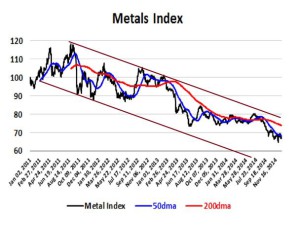 The mining companies have seen their top line revenue diminish dramatically as metals commodity prices have fallen this year. The metals index illustrated in the chart above has declined from 75.86 at the start of the year to 67.04 as of the end of last week, ie -11.62%. The industry, both the major and junior mining companies, have responded to the lower price structure by seeking ways to improve efficiency and reduce both short and long-term average and total costs.
The mining companies have seen their top line revenue diminish dramatically as metals commodity prices have fallen this year. The metals index illustrated in the chart above has declined from 75.86 at the start of the year to 67.04 as of the end of last week, ie -11.62%. The industry, both the major and junior mining companies, have responded to the lower price structure by seeking ways to improve efficiency and reduce both short and long-term average and total costs.
Productivity in mining has been in decline over the past decade as the focus was on output at any cost in an unprecedentedly high commodity price environment. Economists refer to productivity as “multifactor” in that a range of factors are measured, including labour, capital and material (the resource itself). These factors frequently have their productivity reported individually, eg capital productivity in Australia has declined 45% since 2000.
Each key factor has endured a productivity decline across most of the mining sector and board level executives universally report that productivity is the leading challenge that they face heading into the New Year.
In addition there has had been a decline in economies of scale as the complexity of managing ever larger mining projects has risen, given the shortage of highly skilled mine shaft, pit head and technical staff. The industry has had a genuine problem over the past two years, but it has come to a head in 2014 as mining companies try to pinpoint exactly what is the minimum efficient scale of operation.
Until now, the majority of productivity initiatives have solely focused on cost cutting exercise which have generate a mixed bag of modest, short-term results. The thinking as we look forward to 2015 is that mining companies have to progress beyond single-point solutions by pursuing end-to-end solutions to transform the business. They must work to optimise each part of the process as part of a holistic business system.
To make all agents in a mining company internal value chain be aware of the need to accurately perform and prepare their stage of the process before passing the product to the next stage down the value chain requires a willingness to embrace a model known as “concept-strategy-practice” or CSP. Growth and hence the creation of revenue and eventually profit by the use of CSP has served a number of industries – the auto manufacturing industry for one – well for almost a decade. In an industry such as mining which has endured changes with generally decelerating revenue and profit growth, the need for an evolution into a globally integrated enterprise to deliver savings and leverage synergies is obvious.
If the mining companies are to transform, CSP’s must communicate a global vision, identify strengths and weakness, opportunities and threats so that the reason for adopting a process to achieve continuous improvement that can capture the benefits of economies of scale and scope is understood and accepted.
Part and parcel of the CSP approach is to shed the industry of its reputation as an environmental polluter. The mining industry is making much better use of greener technologies to ensure its operations are more energy efficient and have a less degrading impact on the environment. In short, being more attentive to the process now can feed the bottom line tomorrow as expensive clean up charges are avoided.
One example is the deployment of mobile and portable rigs. These measure four square metres compared with 20 square metres for semi-permanent units. In their construction the heaviest item weighs no more than 200 kilograms and that allows regions once seen as too remote for working to become accessible. The rigs can be more readily transported to high altitudes above 1200 metres and in mountainous environments. Local people can carry the components along established tracks which provides local employment for people, who then can learn to assemble the drilling rig and be taught to drill. This eliminates the need to disturb the environment by making further tracks to haul vehicles through, reducing carbon emissions by vehicles and saving time and money.
Another environmentally friendly example is seen with hybrid engine technology. Loaders that can remove several tonnes of ore are used by some 95% of underground metal mines. Many run on diesel and as such they are a huge underground atmosphere polluter, which needs to be counteracted with sufficient ventilation.
Hybrid engines enable a decrease in noxious gas emissions of 60% and when combined with a high-efficiency filter, enables a reduction in breathable combustible dust emissions of 95%. This results in a 40% reduction in the energy required to ventilate a mine, which accounts for about 35% of the electricity costs of underground mining operations.



